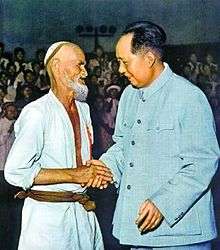Kurban Tulum
Kurban Tulum (Uyghur: قۇربان تۇلۇم, ULY: qurban tulum , Chinese: 库尔班・吐鲁木; 1883[2] – May 26, 1975), also called Uncle Kurban (Chinese: 库尔班大叔), was a Uyghur who lived in Yutian County, Xinjiang, China in what was the Keriya oasis.[2][3] He has been promoted by the Communist Party of China as a symbol of unity with the Uyghurs.[4]
Kurban Tulum | |
|---|---|
 Colorized photo of Kurban Tulum's meeting with Mao Zedong | |
| Born | 1883 |
| Died | May 26, 1975 (aged 91–92) |
| Occupation | Farmer, Electrician[1], Politician |
Life
According to local cadre, prior to the arrival of the Communist Party, Kurban was a peasant who worked as a seasonal laborer for Uyghur landlords. During the land reforms of 1952, Kurban received land and various other properties.[2] He is said to have visited Urumuqi, the political center of Xinjiang, by riding a donkey, to show his appreciation of the People's Liberation Army's role in the liberation of his area.[3] He tried to hitchhike to Beijing, but was unsuccessful.[2]
In May 1958, he was chosen as part of the agricultural delegation to Beijing. The delegation reached Beijing on June 18, and they met with Mao Zedong on June 28, 1958.[2]
He was elected as one of the delegates to the 2nd National People's Congress in 1959 and 4th National People's Congress in 1975.[5]
Legacy
Today, the monuments of his shaking hands with Chairman Mao stand at the center of Keriya and in Tuanjie Square of Hotan, the center of his area.[3]
A song "Where Are You Going, Uncle Kurban?" (Chinese: 库尔班大叔您去哪儿?) was later made and a film Uncle Kurban Visits Beijing (Chinese: 库尔班大叔上北京) was made in 2002. He is a well-known figure in China as his name also appears in the school textbooks.[3]
A 2019 TV series Uncle Kurban and His Descendants (Chinese: 库尔班大叔和他的子孙们) dramatized the overthrow of his landlord and his descendant's career in becoming an officer in PLA Navy.[6][7]
See also
- Propaganda in the People's Republic of China
References
- Moore, Malcolm (8 August 2008). "China tightens grip on western province Xinjiang". The Telegraph. Retrieved 20 December 2019.
In the middle of the square, giant statues of Chairman Mao and Kurban Tulum, an Uighur farmer and electrician who crossed the Taklamakan desert to meet China's premier.
- Hayes, Anna; Clarke, Michael (2015). Inside Xinjiang: Space, Place and Power in China's Muslim Far Northwest. Routledge. ISBN 9781317672500. Retrieved 2017-06-29.
- "Kurban Tulum meets Mao Zedong". centralasiatraveler.com. Archived from the original on 2014-11-29. Retrieved 2017-06-29.
- Kurban Tulum and Chairman Mao Zedong Monument, Unity Square, Hotan, Xinjiang, China
- 新疆自治区党委统战部 (2016-12-30). "库尔班•吐鲁木与八枚证章背后的故事". The United Front Work Department of CPC Central Committee. Retrieved 2017-06-29.
- Teixeira, Lauren (October 3, 2019). "China's Entertainment Future Is Guns, Trains, and Loving the Party". Foreign Policy. Retrieved 27 November 2019.
Xinjiang, currently the target of a massive crackdown, is also the setting for Uncle Kurban and His Descendants, a drama on the list that once more dusts off the story of Kurban Tulum
- "库尔班大叔和他的子孙们" [Uncle Kurban and His Descendants] (in Chinese). Douban. 2019. Retrieved 27 November 2019.
| Wikimedia Commons has media related to Kurban Tulum. |